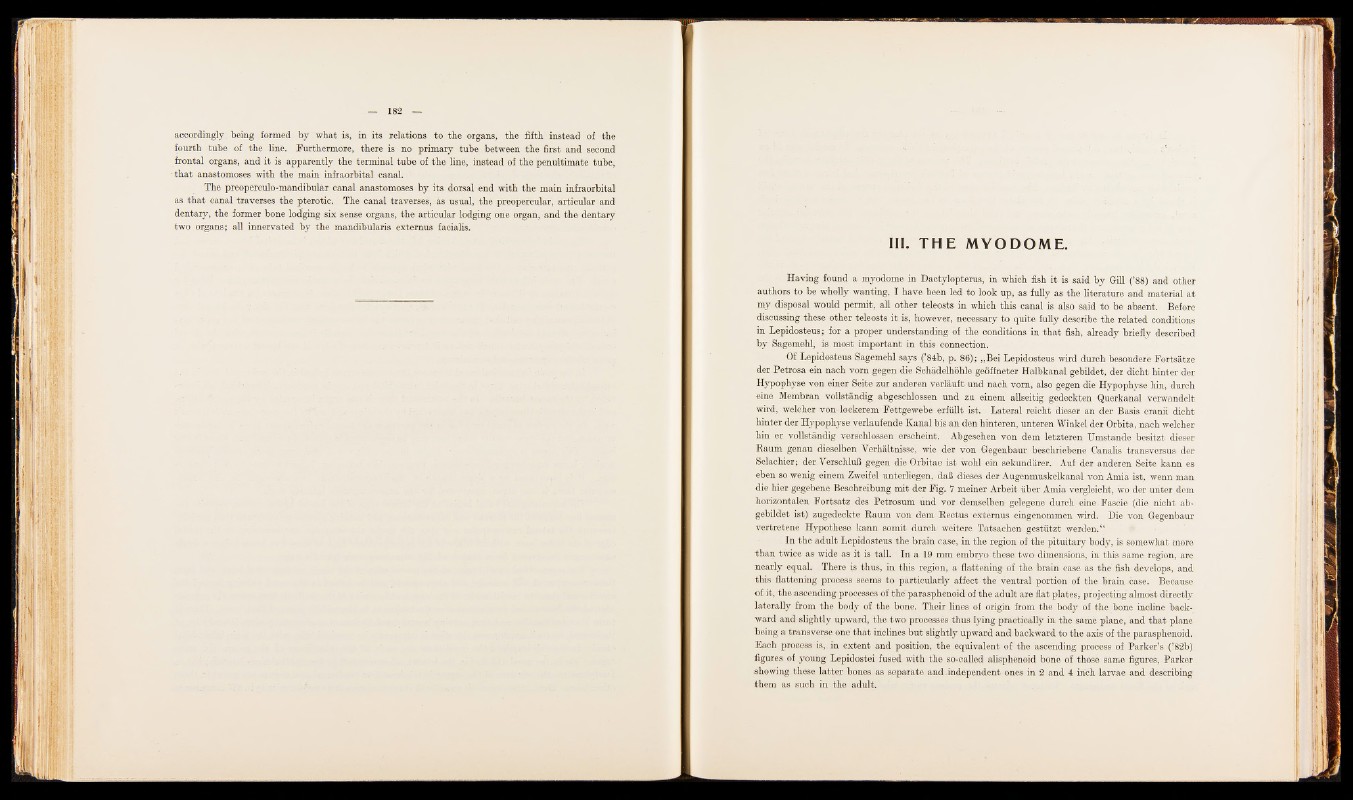
accordingly being formed by what is, in its relations to th e organs, th e fifth instead of the
fourth tube of the line. Furthermore, there is no primary tube between th e first and second
frontal organs, and it is apparently th e terminal tube of th e line, instead of th e penultimate tube,
• th a t anastomoses with the main infraorbital canal.
The preoperculo-mandibular canal anastomoses by its dorsal end with th e main infraorbital
as th a t canal traverses th e pterotic. The canal traverses, as usual, the preopercular, articular and
dentary, th e former bone lodging six sense organs, th e articular lodging one organ, and th e dentary
two organs; all innervated by th e mandibularis externus facialis.
III. THE MYODOME.
Having found a myodome in Dactylopterus, in which fish it is said by Gill (’88) and other
authors to be wholly wanting, I have been led to look up, as fully as the literature and material at
my disposal would permit, all other teleosts in which this canal is also said to be absent. Before
discussing these other teleosts it is, however, necessary to quite fully describe the related conditions
in Lepidosteus; for a proper understanding of the conditions in th a t fish, already briefly described
by Sagemehl, is most important in this connection.
Of Lepidosteus Sagemehl says (’84b, p. 86); „Bei Lepidosteus wird durch besondere Fortsätze
der Petrosa ein nach vorn gegen die Schädelhöhle geöffneter Halbkanal gebildet, der dicht hinter der
Hypophyse von einer Seite zur anderen verläuft und nach vorn, also gegen die Hypophyse hin, durch
eine Membran vollständig abgeschlossen und zu einem allseitig gedeckten Querkanal verwandelt
wird, welcher von lockerem Fettgewebe erfüllt ist. Lateral reicht dieser an der Basis cranii dicht
hinter der H ypophyse verlaufende K anal bis an den hinteren, unteren Winkel der Orbita, nach welcher
hin er vollständig verschlossen erscheint. Abgesehen von dem letzteren Umstande besitzt dieser
Raum genau dieselben Verhältnisse, wie der von Gegenbaur beschriebene Canalis transversus der
Selachier; der Verschluß gegen die Orbitae ist wohl ein sekundärer. Auf der anderen Seite kann es
eben so wenig einem Zweifel unterliegen, daß dieses der Augenmuskelkanal von Amiä ist, wenn man
die hier gegebene Beschreibung mit der Fig. 7 meiner Arbeit über Amia vergleicht, wo der unter dem
horizontalen Fortsatz des Petrosum und vor. demselben gelegene durch eine Fascie (die n ic h t'a b gebildet
ist) zugedeckte Raum von dem Rectus externus eingenommen wird. Die von Gegenbaur
vertretene Hypothese kann somit durch weitere Tatsachen gestützt werden.“
In the ad u lt Lepidosteus th e brain case, in the region of the pituitary body, is somewhat more
th a n twice as wide as it is tall. In a 19 mm embryo these, two dimensions, in this same region,, are
nearly equal. There is thus, in this region, a flattening of the brain case as the fish develops, and
this flattening process seems to particularly affect th e ventral portion of the brain case. Because
of it, th e ascending processes of the parasphenoid of the a dult are flat plates, projecting almost directly
laterally from the body of the bone. Their fines of origin from th e body of the bone incline backward
and slightly upward, the. two processes thus lying practically in the same plane, and th a t plane
being a transverse one th a t inclines b u t slightly upward and backward to the axis of the parasphenoid.
Each process is,, in extent and position, the equivalent of the ascending process of Parker’s (’82b)
figures of young Lepidostei fused with th e so-called alisphenoid bone of those same figures, Parker
showing these la tte r bones, as separate and, independent ones in 2 and 4 inch larvae and describing
them as such in th e adult.